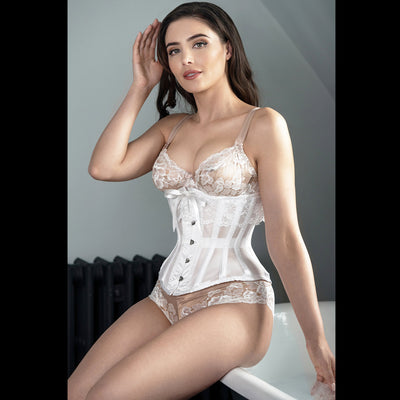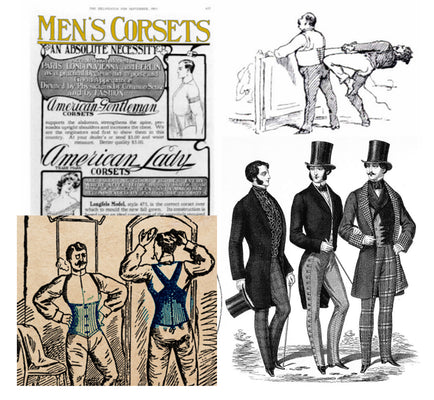Corsets in Fashion: A Full History
Ever wondered what the corset has looked like throughout history? Discover the full guide to corsets in fashion, starting as early as 1600BC...
Corsets have a longstanding a rich history within the fashion industry. Worn for hundreds, possibly even thousands of years, the corset has not just been used for practical reasons, but as a fashion statement too. Read on to discover the history of corsets in fashion, from very early examples right up until the 21st century…
The First Recorded Corset…
The first known recorded example of a corset worn for fashion purposes dates back to Minoan people, in Crete, Greece. Images painted onto ancient pottery shows both men and women wearing form fitting belts around the waist, complete with vests with leather rings or straps. The belts and vests are painted in gold, and are the focal point creating an eye catching fashion statement.
The 15th Century…
While we understand that corsets might have been worn as early as 1600BC, from the 15th century onwards we have better records of the type of corsets that were in fashion. During the 15th century, a corset like garment called a ‘cotte’ was first made popular in France. The cotte had a similar shape to the corsets that we know today, but it didn’t provide much coverage to the bust, and featured a square neckline with wide set straps to reveal the upper bust and collarbones.
Corsets became more revealing in the 15th century. Agnes sorel, mistress to Charles VII of France changed the history of the corset when she wore a gown in French court which exposed her breasts. A trend began, and French women started to open their corsets to reveal their breasts. A little later, another trend started - showing the lower back, and so women wore short corsets and would cut open their dresses to display this.
The 16th Century…
During the 16th century, the fashion for a slender waist increased further, when Catherine de Medici banned ‘thick waists’ at court. This meant that wealthy women in public view were expected to wear corsets at all times. The corsets of the 16th century were laced at the front and back, with a decorative panel called the ‘stomacher’ to conceal the laces.
In Spain in the 16th century, corsets used a wooden or bone rod called a ‘busk’ at the front, which created a flat shape. In England the ‘Tudor Corset’ used iron corset covers, whereas in Germany and Italy, a less rigid style was preferable.
Corsets of this time were designed to flatten the waist and push the breasts up. Many had shoulder straps and flaps at the waist. They were worn alongside a ‘farthingale’ that would hold skirts out in a stiff shape. Corsets were not hidden under additional layers, instead they were worn proudly and made from beautiful fabrics with patterns and trim.
The 17th Century…
Throughout the 17th century, corsets were mostly made from linen, with reeds or whalebone to add structure. At the time it was fashionable to have a prominent bust, and so corsets helped to accentuate this and put more focus on the décolletage.
Corsets sometimes were worn with attached sleeves and the styles become very decorative. Lace was used heavily on corsets of the 17th century, and some women would even add extra ribbons to enhance the style further. The shape of the corset during this time featured a long pointed busk and the styles were typically laced at the back, much like today’s corsets. A little later in the 17th century, corsets briefly fell out of fashion os boned dresses became popular, and it’s unlikely that women would have worn a boned dress as well as a corset.
The 18th Century…
The fashion for a slim waist developed even further in the 18th century, with more demand for a constricted shape. Because of this, corsets were made from stiff material using whalebone or cane for support. The 18th century style was low waisted and cut narrow at the back and wide at the front. Corsets had shoulder straps, and the fashion was to use the straps and the corset to pull the shoulders back until they almost touched.
The corsets typically had tabs, which were made by making cuts from the lower edge up to the waistband. This gave the hips more room, while still pulling in the waist and pushing the bust upwards. Highly decorative corsets were still in fashion, using silk brocade and gold trim. Towards the end of the 18th century, corsets started to become shorter and waistlines became higher.
The 19th Century…
Both longline and shorter corsets were worn during the 19th century and were made of sateen, cotton or silk. Corsets were often given as gifts to women by their husbands. Some 19th century corsets would use as many as 60 whalebones to create the illusion of a tiny waist.
During this period the front fastening busk was introduced in 1848, which for the first time enabled women to put her corset on easily by herself. The new busk featured gentle curves to follow the natural lines of the body.
The 20th Century…
In the early 20th century, the focus on creating a small waist shifted, and instead women wanted to minimise their stomach and hips. Because of this, corset styles changed quite dramatically, and the first ever underbust corset was introduced. The waist of the corset sat just above the natural waistline, and corsets were cut long and straight in the body. The styles became very long and often ended at mid thigh. Corset styles were simple as they were now worn under the clothes and discreetly. In the ‘20s, more relaxed shapes and straight lines became popular. Flapper dresses meant that a boyish shape was desirable, and so corsets changed a little in order to slim the hips and thighs as much as possible. Corsets of this time were worn under clothing and fastened at the front and back. A variety of styles became available, such as the ‘sports corset’ and ‘hip confiners’.
Moving forward to the ‘30s and ‘40s, corsets were still long, but began to include build in brassieres. Known as the full body corset, this style was still worn discreetly under clothing. From the ‘50s onwards, fashion began to change at a rapid pace, and this saw the corset become more of a specialist garment, instead of being worn as an essential everyday piece.
Modern Day…
Today corsets are still worn by enthusiasts. While they are not considered an everyday item, advances in technology and manufacturing means that the corsets of today are of better quality than ever before. In the 21st century, corset tops are worn as outerwear, whereas more traditional corsets can be worn as a statement piece, or as an undergarment to reduce the waist and provide support.
Throughout the years, various designers have used corsets as part of their collection, from more traditional styles to reimagining this historial garment.
As you can see, the corset has a rich history, and has been worn and cherished for thousands of years. While the corset is no longer an everyday item, today it offers impressive benefits, and is ideal for special occasions or to create your own unique modern style. To browse our collection of modern corsets, click here: sales@corset-story.nl






